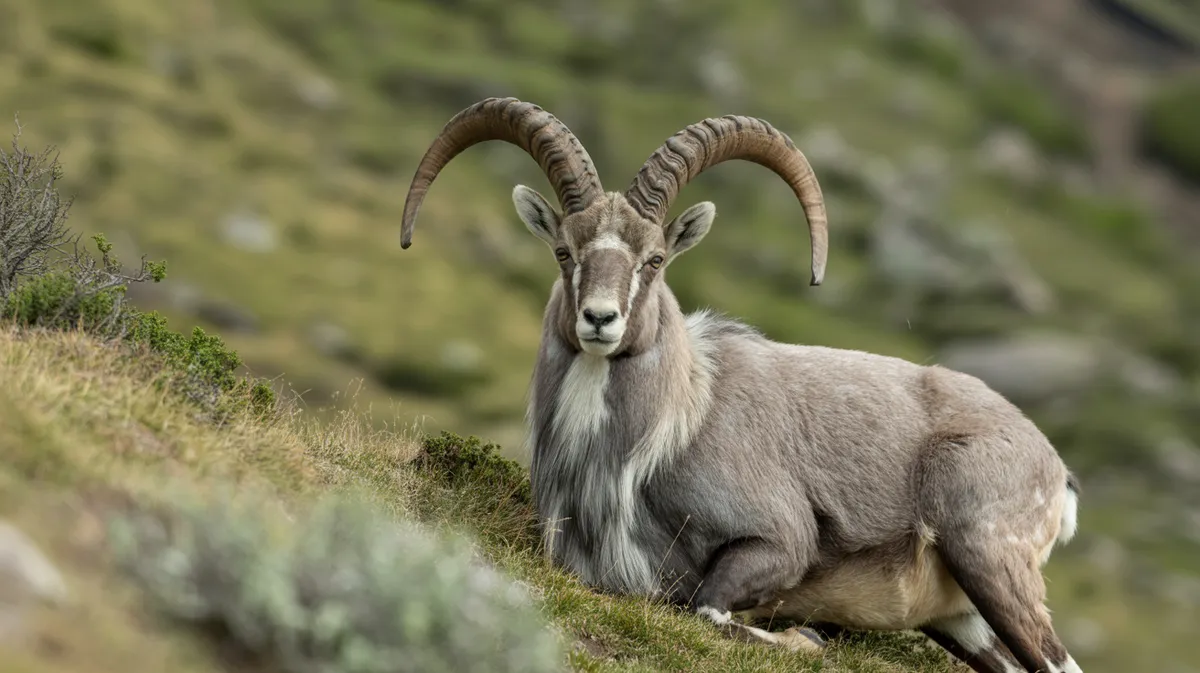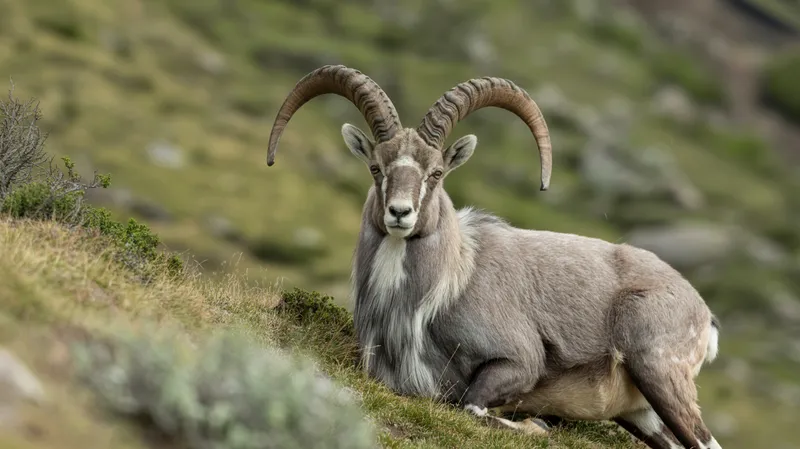
Bharal (Himalayan Blue Sheep)
Pseudois nayaur

Meet the Bharal (Himalayan Blue Sheep)
The bharal, also known as the Himalayan blue sheep, is a robust mountain ungulate native to the high Himalayas. Sporting a bluish-grey coat that provides perfect camouflage among rocky slopes, bharal are well-adapted to steep, rugged terrains at elevations between 2,500 and 5,500 meters. Males possess impressive, backward-curving horns, while females have shorter, slender horns. Highly social, bharal often form large herds and are noted for their agility, which helps them evade predators like snow leopards. Despite their name, bharal are not true sheep or goats but exhibit characteristics of both.
Classification
Mammal
Habitat
Mountain slopes and alpine meadows
Diet
Herbivore
Lifespan
10-15 years
Conservation
Least Concern
Weight
35-75 kg
📖Fascinating Facts
Not a True Sheep
Despite the name 'blue sheep,' bharal are not true sheep or goats but belong to a unique genus with traits of both.
High-Altitude Expert
Bharal thrive at some of the highest altitudes of any ungulate, often seen grazing above 4,000 meters in the Himalayas.
Key Prey
They are a primary prey species for the elusive snow leopard, supporting the balance of the high-altitude ecosystem.
📋Detailed Description
The bharal (Pseudois nayaur), commonly known as the Himalayan blue sheep, is a medium-sized caprid uniquely adapted to the high-altitude environments of the Himalayas and adjoining mountain ranges. Adult males typically weigh between 60 and 75 kg and measure 115 to 165 cm in body length, while females are smaller, averaging 35 to 50 kg. Their dense, woolly coat is slate-blue to gray, providing effective camouflage against rocky alpine terrain. Males are distinguished by thick, ridged horns that curve outward, backward, and then inward, reaching up to 80 cm in length, whereas females have shorter, thinner horns rarely exceeding 20 cm. Bharal possess a robust build, with strong limbs and specialized hooves featuring a hard outer rim and soft, grippy pads that enable exceptional agility on steep, unstable slopes. They are highly social, forming herds ranging from small family groups to aggregations of over 100 individuals, especially outside the breeding season. Their diet consists mainly of grasses, herbs, and sedges, but they also browse on shrubs and lichens during winter scarcity. Bharal are crepuscular, being most active during early morning and late afternoon. Their keen eyesight and coordinated group vigilance help them detect and evade predators such as snow leopards and wolves.
💡 Did you know?
Bharal were at the center of a famous ecological study in the 1970s that led to the creation of India's first national park, the Valley of Flowers.
🔬Research & Sources
🎭Behavior & Social Structure
Bharal exhibit complex social structures, with herds typically segregated by sex outside the rutting season; females and juveniles form nursery groups, while males often form bachelor herds. During the day, they alternate between grazing and resting, using rocky outcrops for shelter and vantage points. Feeding is primarily on low-growing alpine grasses and forbs, with seasonal shifts to woody plants and lichens in harsher months. Bharal are highly vigilant, relying on their acute vision and group alarm responses to detect predators. When threatened, they employ a freeze-and-flee strategy, remaining motionless to blend with rocks before making sudden, agile escapes across precipitous terrain. Dominance hierarchies are established among males through ritualized displays and occasional horn clashes, especially during the breeding season. Vocalizations are limited, with most communication occurring through body language and scent marking.
👶Reproduction & Life Cycle
The mating season, or rut, occurs from late November to January, during which males compete for access to females through displays and sparring. Dominant males guard small groups of estrous females. After successful mating, females undergo a gestation period of approximately 160 to 170 days, giving birth to one, rarely two, lambs between May and June. Births coincide with the onset of summer, ensuring optimal forage availability for lactating mothers. Newborns are precocial, able to stand and follow their mothers within hours. Maternal care is pronounced, with lambs kept in secluded rocky crags for protection during their first weeks. Weaning occurs at around 4 to 6 months, but juveniles remain with maternal groups for up to a year.
🛡️Adaptations & Survival
Bharal are superbly adapted to life at elevations ranging from 2,500 to 5,500 meters, where oxygen levels are low and temperatures can be extreme. Their compact, muscular bodies and short limbs reduce heat loss and facilitate efficient climbing. Specialized hooves with a hard outer rim and soft, concave pads provide traction on loose scree and steep rock faces. Their thick, insulating coat protects against cold and wind. Physiologically, bharal exhibit adaptations for hypoxia, including increased lung capacity and high concentrations of red blood cells. Behavioral adaptations include seasonal altitudinal migrations to track forage availability and minimize exposure to deep snow. Their cryptic coloration and group vigilance are key anti-predator strategies.
📚Research Sources
🎨Cultural Significance
Bharal hold significant cultural importance in Himalayan societies. In Tibetan Buddhism, they are considered sacred and are often associated with mountain deities. Their horns are used in traditional rituals and as trophies. The bharal is a key prey species for the endangered snow leopard, making it central to high-altitude ecosystem dynamics and conservation efforts. In local folklore, bharal are sometimes seen as symbols of agility and resilience. Traditional hunting of bharal has declined due to legal protections and changing cultural attitudes.
🔬Recent Research & Discoveries
Recent genetic studies have clarified the evolutionary relationships of bharal, confirming their placement within the Caprinae subfamily but highlighting their unique adaptations that blur the distinction between sheep and goats. Ongoing research focuses on their role as a keystone prey species for snow leopards and the ecological impacts of livestock competition. GPS telemetry studies have revealed complex seasonal movement patterns and habitat preferences, informing conservation planning. Disease ecology research is examining the risks posed by pathogen spillover from domestic livestock. Climate change impact studies are underway to predict future shifts in bharal distribution and forage availability.
🎥Wildlife Videos

Himalayan blue sheep - Bharal
The bharal or Himalayan blue sheep or naur (Pseudois nayaur) is a caprid found in the high Himalayas of Nepal, Tibet, China, ...
WildFilmsIndia

Bharal - Himalayan Blue Sheep
Bharal have excellent camouflage in their rocky Himalayan home and will stand motionless when approached, making them ...
Highland Wildlife Park

Blue Sheep (भरल) Great Himalayan National Park
In some of my previous treks I visited a few undisturbed habitats in the Great Himalayan National Park (GHNP), where the elusive ...
Vinay BlueSheep

Namaste Himalaya - A Blue Sheep Expedition
A high altitude hunting adventure of true grit and determination. The Himalayas of Nepal turned out to be CANIS founder Ryan ...
CANIS

All 8 Wild Sheep Species (Including 2 Controversial)
Explore all 8 wild sheep species including all 6 members in the Ovis genus and two other closely related animals. Chapters 0:00 ...
Textbook Travel

Bharal - Himalayan Blue Sheep
Spotting Bharal (Himalayan Blue Sheep) is quite an unexpected delight while on a winter trip to Spiti.
The Mountain Walker
🌍Habitat Information
The Bharal (Himalayan Blue Sheep) typically inhabits Mountain slopes and alpine meadows environments. Bharal (Himalayan Blue Sheep)s have adapted to their environments with specialized features and behaviors.
Primary Habitat:
Mountain slopes and alpine meadows
More detailed habitat information will be available soon.
🛡️Conservation Status
The Bharal (Himalayan Blue Sheep) is currently classified as Least Concern. Conservation efforts are crucial for preserving this species for future generations.
Common Threats:
- 🏠Habitat loss and fragmentation
- 🌡️Climate change impacts
- 🎯Hunting and poaching
- 🏭Human-wildlife conflict
⚠️Threats & Conservation Challenges
While the IUCN lists the bharal as Least Concern due to its wide distribution and stable populations, localized threats persist. These include habitat degradation from overgrazing by domestic livestock, competition for forage, and disease transmission from domestic sheep and goats. Poaching for meat, horns, and traditional medicine poses a threat in some regions. Infrastructure development and human encroachment are fragmenting habitats, particularly in the eastern Himalayas. Climate change may alter alpine vegetation patterns, affecting food resources. Despite these challenges, many bharal populations benefit from protection within national parks and reserves, and some are stable or increasing.
🔬Scientific Classification
Scientific Name
Pseudois nayaur
Classification Hierarchy
🔍 About Taxonomic Classification
Taxonomic classification is a hierarchical system used by scientists to classify and organize living organisms based on shared characteristics and evolutionary relationships.
The system moves from broad categories (Kingdom) to increasingly specific ones, with each animal's scientific name typically consisting of its Genus and species.
📝Community Notes
Share your observations and insights about the Bharal (Himalayan Blue Sheep) with our community of wildlife enthusiasts.
Join Our Community
Sign in to share your observations and connect with fellow wildlife enthusiasts.
Sign In to ContributeNo community notes yet
Be the first to share your observations about the Bharal (Himalayan Blue Sheep)!
Explore Bharal (Himalayan Blue Sheep)
Select a tab above to learn more about this amazing animal.
📸Photo Gallery
No photos available for this animal yet.
🌟Discover More Wildlife
Continue your journey of discovery with more fascinating animals from our database
